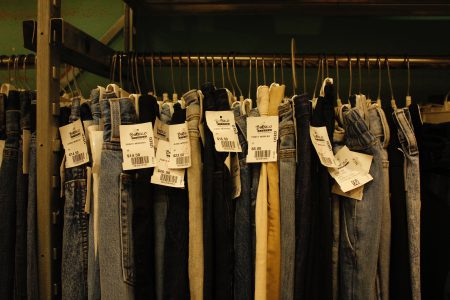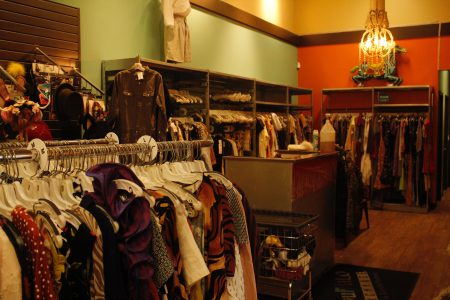The peak of social media is now upon us. With apps like TikTok and Instagram, there are now hundreds of thousands of people telling you what the latest trends are. Two of the many trends are shopping from fast fashion websites and thrifting. These seem to be at odds — but the two trends are more connected than we might think. Thrifting is being praised everywhere on the internet, but is this a good thing?
You might think, now I can shop affordably and ethically in peace, but that is not the case. Donating to thrift stores may be more detrimental than we think. With the rise of thrifting alongside the rise of fast fashion, Americans buy five times more clothing now than they did in 1980, according to The Atlantic. British charity Barnardos surveyed 1500 women and found that the majority of fashion purchases are only worn seven times. This is where thrift stores come into play.

Once you’ve donated your no longer useful clothing, where does it go? Less than 20% of clothing donations sent to charities are actually resold at said establishments, according to Nylon. About two-thirds of thrift store discards don’t make it to textile recycling and inevitably end up in the landfill. According to the United States environmental protection agency, landfills received 11.3 million tons of municipal solid waste textiles in 2018.
When it comes to fast fashion brands, it gives you that satisfaction of being trendy but for how long? Fast fashion can be defined as when a company takes a piece of clothing and mass produces it at incredible speed, manufacturing hundreds of new clothing items every day. The ideal goal for these companies is to get the pieces out as soon as possible to let shoppers buy them at the peak of popularity. Since it is made so quickly, the quality of the clothing decreases, leading to buyers discarding the items after a few wears. This plays a key part in overproduction and consumption that has made fast fashion one of the world’s largest polluters. According to the New York Times, about 85% of textile waste in the United States goes to landfills and will not decay, due to the clothes’ synthetic makeup. Synthetic microfibers end up in the sea, including the deepest parts of the oceans and on glacier peaks.
Some people turn to donating their fast fashion purchases under the assumption that someone out there will get more use out of that top. In some cases, someone will, but it may not be as often as you think. According to Nylon, 80% of clothing that’s not sold at the retail establishment where it’s donated is sent to textile recyclers who then sort through and determine the next life for these clothes.
Micheal Ramirez is an employee at Hope Thrift Store. He explains this process and says, “When people donate clothing we dump everything onto a conveyor belt. Then we separate it into three categories: sellable items, damaged linens and ragout. Ragout is all damaged clothing. Ragout goes into a pallet box which is then dumped into a baler machine which condenses the clothing into 500 to 600 lb bales. We then sell 30 to 34 bales at a time to commodity brokers. These brokers take care of transportation and packaging and bales are then shipped overseas.”
Roughly 700,000 tons of clothing are sent to East African countries. In Kenya, the cost of a resold item of clothing is 5% the cost of a locally made item, according to Green America. This means they have grown to rely on other countries and it has caused harmful results on their local economy. In 2016, the East African Community agreed to ban imported clothing that would have gone fully in effect in 2019 but was blocked by former President Donald Trump’s administration. This forced Kenya’s small businesses to upscale to satisfy demand. Many could not afford to do so, resulting in many business closing.
There’s no easy solution on what to do with our used clothes and fast fashion purchases. There is always sustainably made clothing from ethically based brands, but those price points can be too high for the average consumer. This is not a route many can take, yet there is an alternative. Online markets such as Depop, Poshmark or ThredUP provide reasonable prices for used clothing and go straight from seller to buyer; there is no question of where your clothes are really going.

TikToker Grace Brinkly is a vintage reseller on Depop who promotes shopping ethically. She explains that a lot of work goes into her store to provide her customers high quality, vintage and ethically sourced clothes. “There is so much time that goes into actually curating a shop and an inventory. It takes me weeks of time and effort and it costs me money of my own,” she says. Brinkly mentions that reselling online is not a new concept. The secondhand apparel market was worth about $28 billion in 2019 and is expected to reach $64 billion in 2024, according to the 2020 Resale Report by ThredUp.
The United States sends away over a billion pounds of used clothing a year. Taking the clothes you once loved and giving it to a new home or reselling it can help our environment. Watching TikToks for hours may be fun, but don’t let yourself get sucked into the never ending trend cycle. These trends turn into microtrends; one day it may be a trend but the next day, it’s not. Next time you see a booming trend on social media think, “Will I still love this in a year’s time?”
